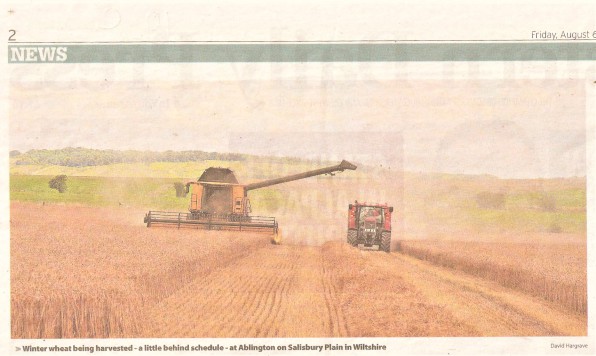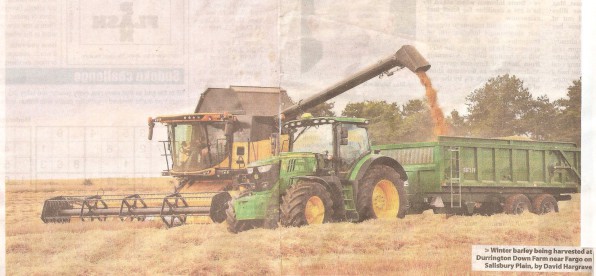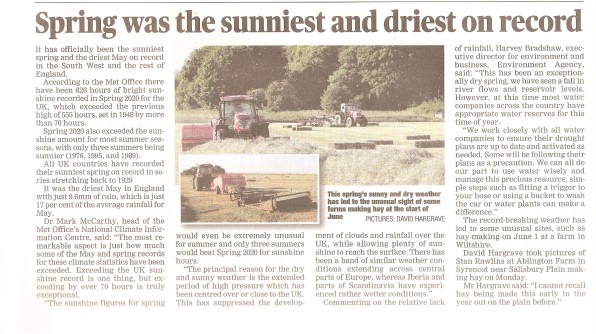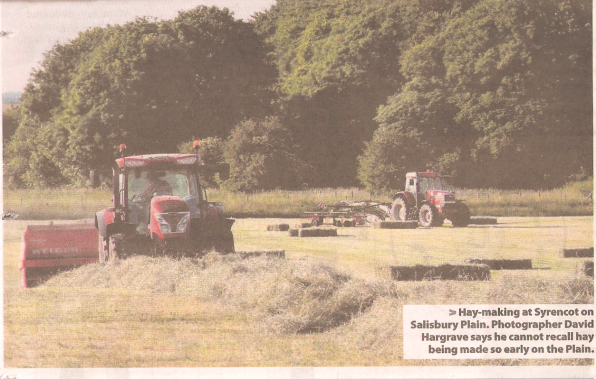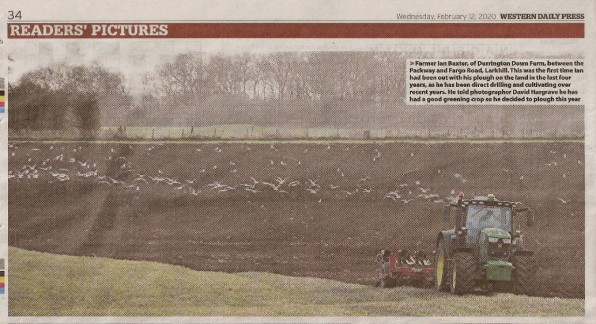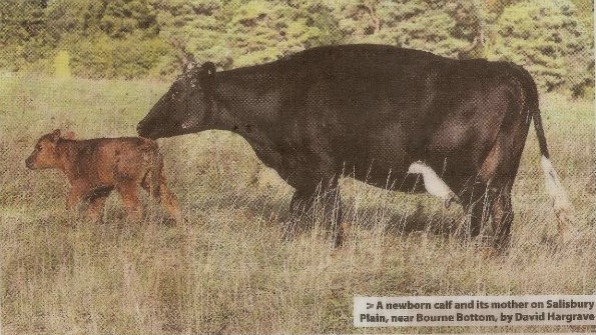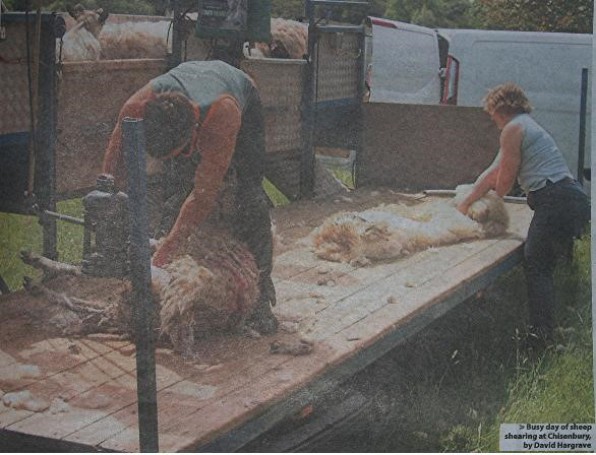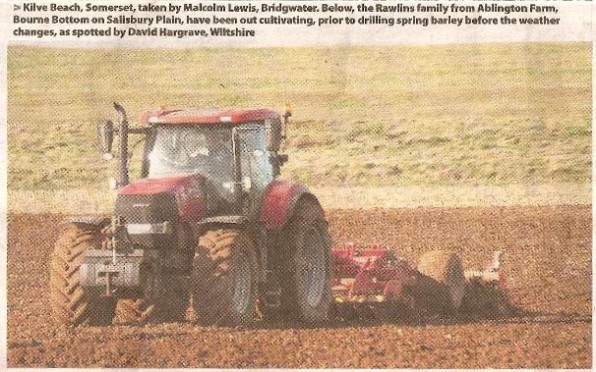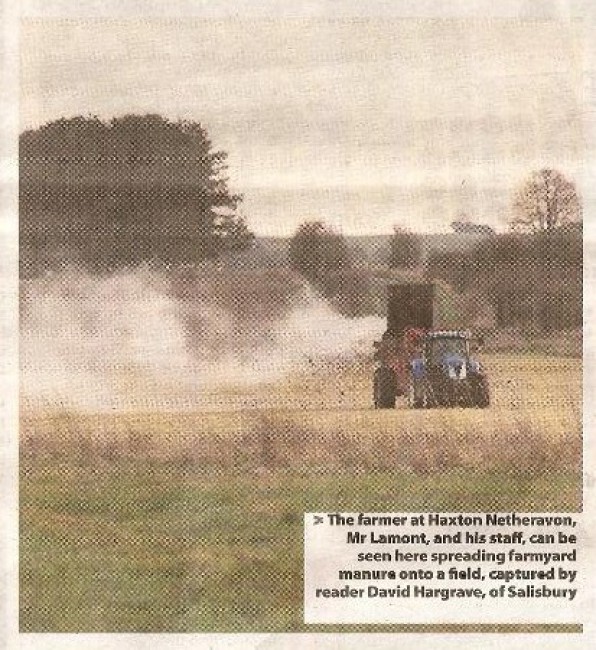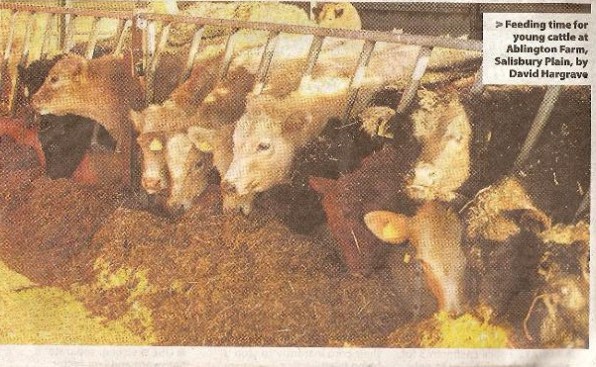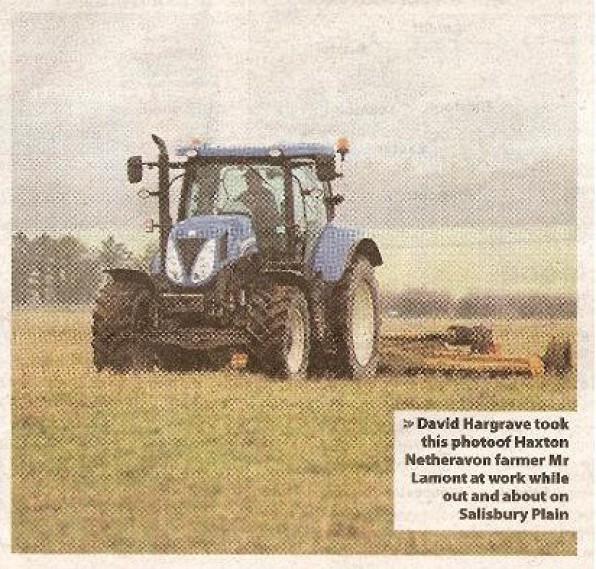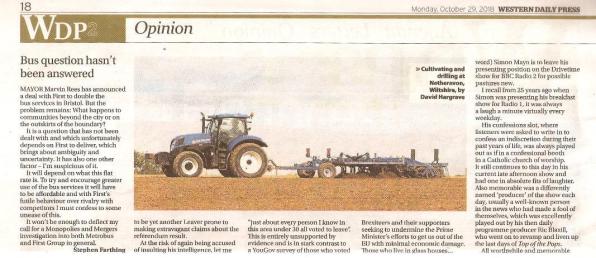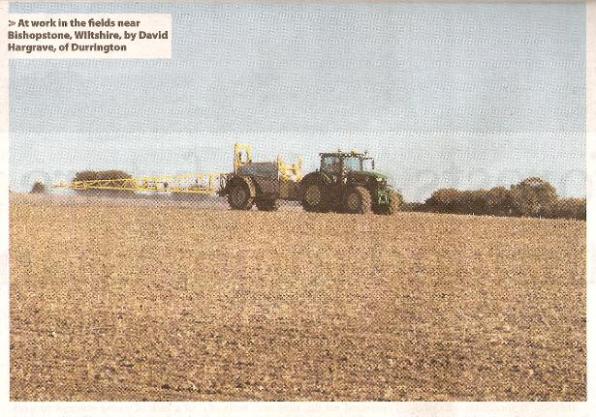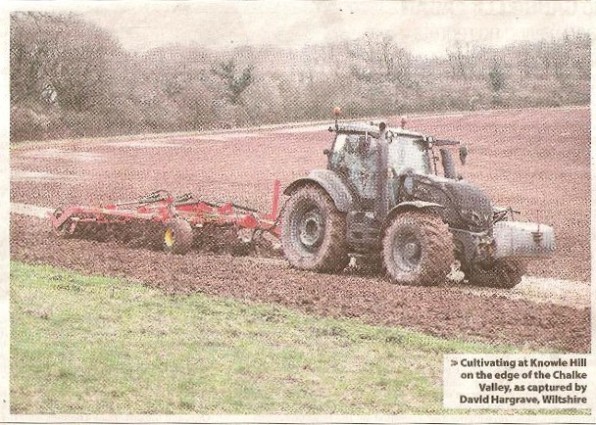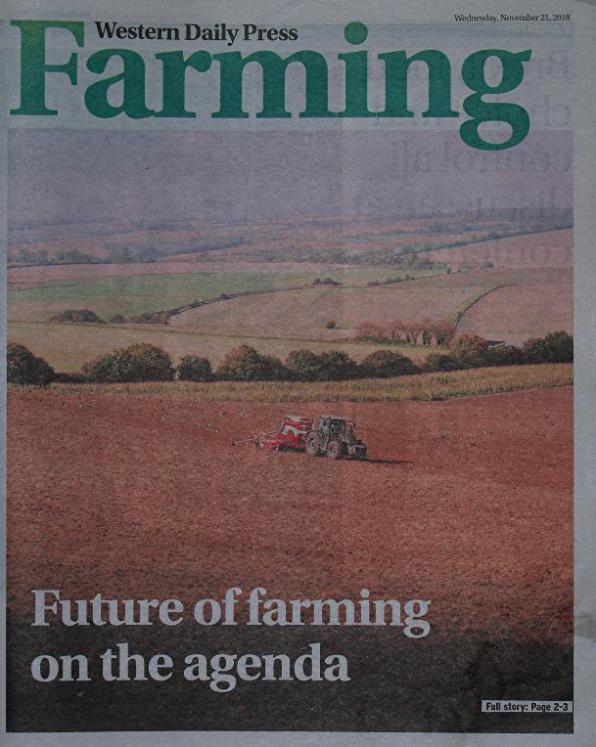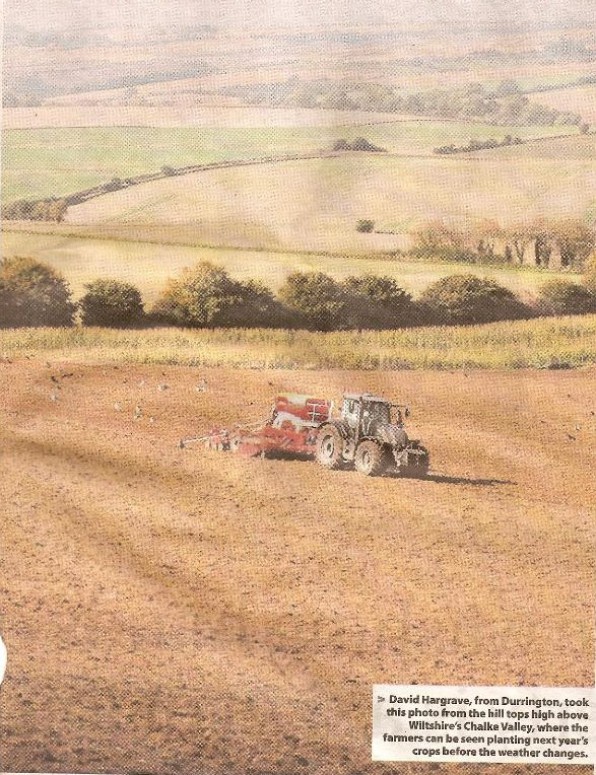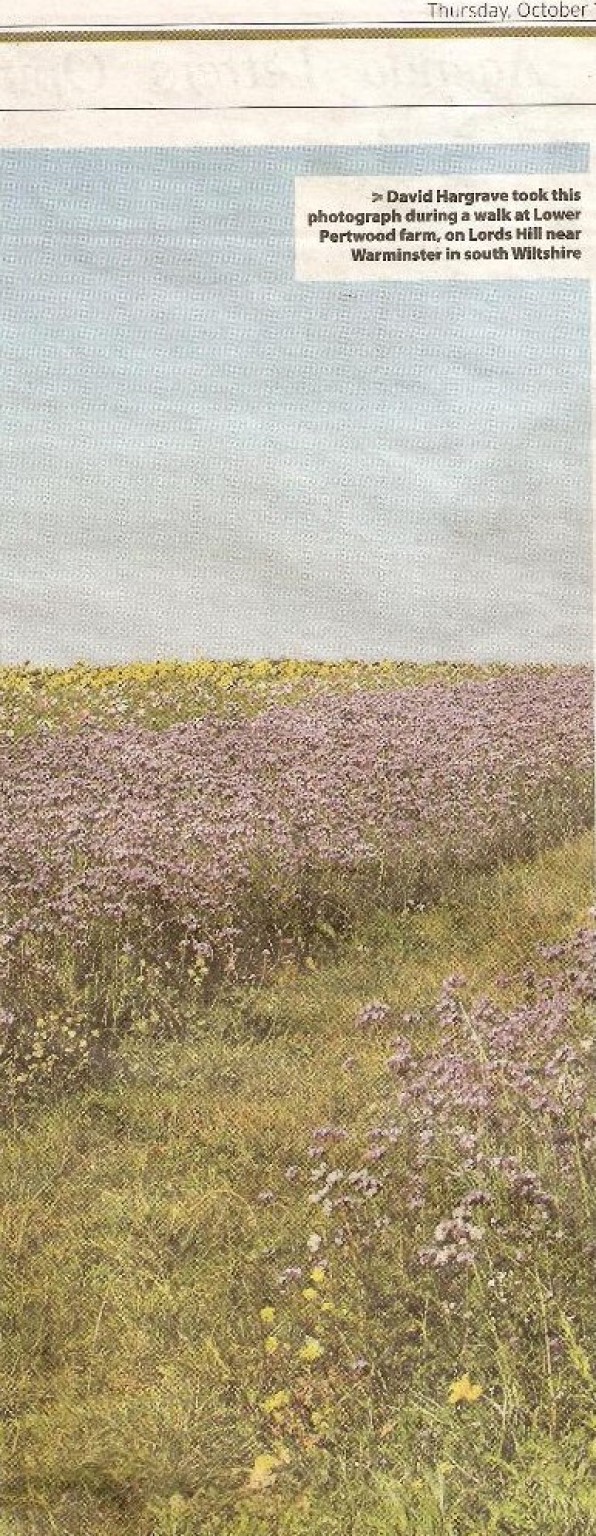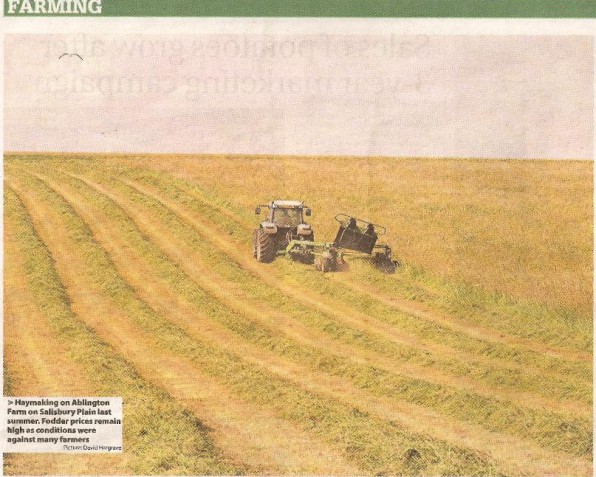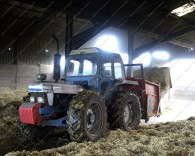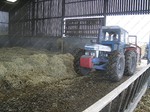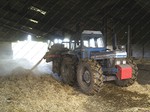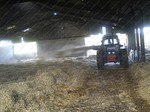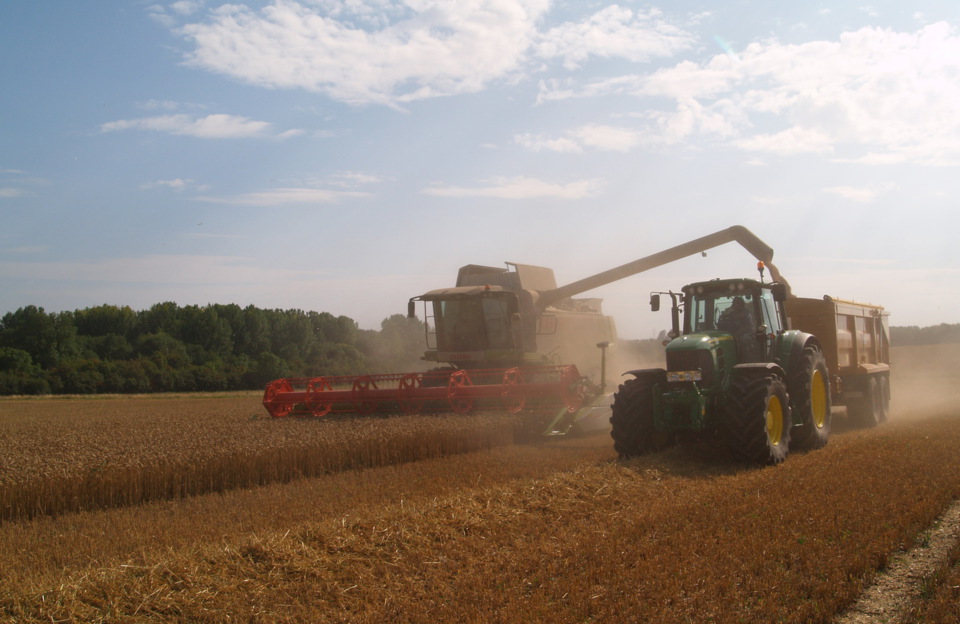
Farming on the Plain
Parson's Family Pumpkin Patch - Milston
This family run farm has launched a PYO 'Pumpkin Patch'.
It is their first year and they have a variety of different shapes and sizes waiting for you to choose, on selected weekends in October 2020.
I understand that a pre-booking system is in place, due to COVID-19. Therefore, book your tickets now and support this family run farm.
Durrington Down Farm - 05.08.20
I was last in this road by this field on 4th June 1969 in the afternoon, about 15.00 I think.
I was at the school in the road, when I saw a jet at a very low level, fly across the sky behind the Officers mess and disappear into the ground.
I was one of the first to get to the crash site and there was little anyone could do, but the pilot had landed further away and the emergency vehicles were there quite
quickly.
The jet in the crash was a Hawker Siddeley Harrier T.2 - Registration: XW174 and was written off following the accident.
The jet had taken off from Dunsfold Aerodrome and its destination was Boscombe Down. It was first flown on 24.04.69 and was written off 04.06.69 due to dirt in the
fuel system causing an engine failure at 3000 ft.
The Pilot surviving the crash was Mr Duncan M.S. Simpson, Test Pilot of HSA Ltd, Dunsfold. He ejected at 100ft and sustained a broken neck due to being struck on
the head by a large fragment of the canopy during the ejection sequence.
Ablington Farm - 01.06.20
This photograph shows Stan Rawlins from Ablington Farm out this evenig in the McCormick X7.660 tractor, towing the Conventional Pick up Baler and Sledge.
This picture was taken at Syrencot near the old airfield on Salisbury Plain.
The Farm has a few customers who use these conventional bales and being downland grass hay, it is quite heavy.
I cannot recall hay being made this early in the year out on the plain but conditions etc are likely to be best we are going to get at present.
Silage Harvest by the Parsons & Rawlins Family - 19.05.20
These photographs were taken on Upper Farm, Milston showing the Parsons Family and their neighbours the Rawlins Family working together to gather the silage harvest.
While they were clearing this field there were six red kites patrolling low above the field, after a free meal of mice and shrews etc, following the machinery.
The Parsons Family have the Rawlins Family helping to harvest some grass for silage at Upper Farm, Milston. The farm grows a lot of grass for silage and hay to feed
their animals through the winter months.
This crop is a high-sugar rye grass mix, drilled in the autumn. These grass crops are now quite common and can provide several cuts of quality silage.
They are very fast growing and are usually only cropped for up to five years, before cereals or oilseed rape would likely be grown, on a rotation.
Drilling Spring Barley on the Old Syrencot Airfield - 23.03.20
These photographs show George Rawlins drilling some spring barley, tonight as the sun set, on the old Syrencot Airfield area, Salisbury Plain.
George Rawlins and Family from Ablington Farm, have been very active in the last week, battling the wet ground conditions. They were out all last week and over the
weekend cultivating, prior to drilling spring barley before the weather changes.
Land Maintenance on Salisbury Plain by Farmers - 18.03.20
These photographs taken recently, show how the Farmers on Salisbury Plain, maintain and restore the grass downland. They rely on this land to get a crop of hay from
each year.
However, when it becomes very wet and military vehicles drive over it at times, the end result is damage.
This year has been exceptionally difficult with lots of very wet weather. In addition, there is now a lot more military activity using the Plain and when the heavy
armour comes out for several days on exercise, severe damage to some areas occurs.
The piece of land shown in the photographs was a World War 2 airfield, this is grazed in plots by the Farmer with a suckler herd, using a mobile penning system of
electric fencing. Then in the spring this ground is rejuvenated and the grass cover encouraged to grow for a crop of hay.
The land being grass downland, is also subject to conservation, therefore, pesticides and and fertilisers are not permitted.
This year the military, who of course own and use the land for training, dealt some areas a challenging, damaging blow with heavy tanks. This looked really bad, but
the Farmer has now been out like a Groundsman after a football match and started to carry out some repair work, when he is able to access the still wet land.
The ground has now received a couple of passes with a heavy set of harrows and then a lighter spring tine cultivator, followed up with a heavy roller.
The Story of 2 Farmers Carrying Out the Same Job but by Different Methods - 18.03.20
These photographs show two Farmers, who are neighbours on Salisbury Plain. They are both preparing plots for spring barley cereals. At first glance they look
almost identical.
Both Farmers had a crop of stubble turnips which were strip fed by suckler herd cattle.
The plot maintained by Richard Parsons is on the downland and is able to access it at all times.
However, it becomes very wet and military vehicles do drive over it at times. The top soil is quite good and deep, but it can become compacted. This means
that Richard is forced into ploughing the land to de-compact it and drain it. He then has to harrow and prepare the land for a seed bed, so the ground takes longer to prepare for the crop and
he has to cover the land several times to achieve the finish.
The photographs show Richard with a power harrow preparing a seed bed.
Things are slightly different for George Rawlins his neighbour. The plot George is preparing is situated inside the fenced area of the live firing ranges, this
means he can only get onto the land when there is no firing and the ground and weather conditions are favourable.
In addition, George has the added problem, in that the topsoil is very shallow, so any deep cultivations or ploughing is not a good option.
George is shown here with a one pass tine and disc roller cultivator preparing the plot for drilling. This is of course a lot quicker and saves on labour, time and
fuel. Less time is available to him to get the next crop in the ground.
Land Grazing Management on Salisbury Plain - 09.02.20
The limited edition tractors were produced by McCormick to celebrate 60 years of agricultural equipment production at its Doncaster headquarters.
Just 60 examples each of the 102hp CX105 and 152hp MTX150 Diamond Edition commemorative tractors became available to UK farmers.
They have a one-off specification, which includes a special silver and dark grey paint scheme, a chromium plated exhaust heat shield and silver-highlighted steering wheel
in addition to an enhanced package of standard equipment.
The tractors were delivered with a numbered commemorative certificate proving their authenticity and provenance.
They could be of particular value in years to come judging by the way that past special edition tractors from the 1970s and 80s are now eagerly sought by
enthusiasts.
The company's international sales director, Simeone Morra, said at the time: "We're very proud of the McCormick heritage and the Doncaster factory's historical role in
the agricultural engineering industry and felt this was an anniversary that should be marked in some way.
Making available to UK farmers just 60 examples each of the CX and MTX Diamond Edition tractors is an appropriate number that also guarantees a certain rarity
value.
Production of agricultural equipment at the Wheatley Hall Road factory started in 1946.
At first it produced agricultural implements such as mowers, balers, ploughs and cultivators to help farmers continue the magnificent efforts they made to increase food
production.
Three years later the factory started assembling McCormick-International tractors.
Land grazing management on Salisbury Plain:
The tenant farmers, use a system of temporary pennings, electric fenced and generally in place for two to three weeks.
This is a unique system that combines short bursts of management with periods of rest. Grazing is recorded by DIO land agents and conservation staff.
The tenant farmers also have ‘voluntary’ scrub management plans, which highlight the easier, toppable areas of scrub on open grasslands.
The photographs show this operation in action during the week:
They are expected to manage on an on-going basis.
Stewardship agreements, in respect of chalk grassland and other interests – and has been the main factor improving the condition status of the chalk
grassland.
The impetus must be to maintain the previously cleared areas and continue with a balanced scrub programme on the rest of the SSSI.
Balancing scrub management for chalk grassland, birds and other interests is a significant challenge on the Plain, given the differing requirements of these habitats and
species.
Durrington Down Farm - 09.02.20.
These photographs show Ian Baxter of Durrington Down Farm between the Packway and Fargo Road, Larkhill.
In the last four years, this was the first time Ian has been out with his plough on the land, as he has been direct drilling and cultivating over recent years. Ian
told me that he had a good greening crop, therefore, decided to plough this year.
This will mean that herbicides will not be used to remove last years crop vegetation and the soil will become de compacted and allow the air into the
soil.
It looks good for the birds, as they follow the plough, looking for a free meal and no doubt forage for some of the in soil pests, in return for the farmer.
New Born Calf Transport! - 23.09.19
These photographs were taken this morning on Salisbury Plain near Bourne Bottom and show a new born calf being being transported back to the farm via tractor with a
livestock box. Mother has to walk along behind keeping an eye on her youngster.
Two of the bulls keep watch over the remaining herd of suckler cattle.
Harvesting Grass for Silage at Upper Farm, Milston - 13.05.19
The Parsons Family have started to harvest some grass for silage at Upper Farm, Milston.
The farm grows a lot of grass for silage and hay to feed their animals through the winter months.
This crop is a high-sugar ryegrass mix, drilled in the autumn.
These grass crops are now quite common and can provide several cuts of quality silage.
They are very fast growing and are usually only cropped for up to five years, before cereals or oilseed rape would likely be grown on a rotation.
Haxton Farm - 18.01.19
Whilst out and about on Salisbury Plain near Coombe Down, Mr Lamont and his staff were seen spreading farm yard manure onto a field, in preparation for ploughing,
cultivation and planting of spring crops.
As can be seen in the photographs, in minus temperatures the rotted manure has reached quite a high temperature, while it was heaped out on the land, over the
winter.
Ablington Farm - 30.11.18
Rob Rawlins is seen here spreading new straw bedding into the pens, where the young cattle will be for the winter months. This is now carried out using a straw
spreading machine, that chops and throws a whole large bale of straw into the covered area, in seconds. This has saved hours of labour.
This was followed by Rob with a mixer and feeder, supplying the young cattle with their breakfast.
Pertwood Organic Farm - 10.10.18
Many people are unaware about the wider benefits of organic farming. At Pertwood it is evident to all who visit. The farm has an extraordinarily high variety and number of wild birds, animals and flowers compared to its non organic neighbours. This has been proven in a Biodiversity Audit and is testament to its long organic history, plus the farm goes further than simply avoiding pesticide and artificial fertiliser use.
Here are just a few examples of good practice:
- purposefully leave areas of winter seed supplies by not ploughing in crop stubbles over winter
- sew wildflower bird seed mixes into large areas to significantly add to wild birds food resources
- leave some areas fallow for ground nesting birds. These are in areas which they are known to like!
- reintroduced permanent grassland to areas which were previously ploughed in order to protect historical features such as a Roman Road. Without this reversion these features could be lost entirely
- graze the farm's ancient down land with native rare breeds, because of a belief in the conservation of genetic resources
At Lower Pertwood, the aim is to secure an environment which reflects the past, as well as servicing the present and looking after the future.
Ablington Farm - September 2018
These photographs show an area of rye grass with red clover being grown as a greening crop. Leys are usually established for two or three years and form a basic part of many organic field, vegetable and arable rotations.
Where animals are present on the farm, the leys would usually be grazed or cut for silage. Such leys may be pure clover (when nitrogen fixation is a priority) or a grass/clover mixture (when organic matter build up is also important). Red or white clover and ryegrass are key species.
This crop was planted in October 2017 and could not be cut until after 1st July 2018, as it is classed as a conservation area. The first cut was made and collected
in the first week of July and these photographs show the second crop being harvested.
Upper Farm Milston - May 2018
The Parsons Family have the Rawlins Family helping to harvest some grass for silage at Upper Farm Milston. The farm grows a lot of grass for silage and hay to feed their animals through the winter months.
This crop is a high-sugar rye grass mix, drilled in the autumn. These grass crops are now quite common and can provide several cuts of quality silage. They are very fast growing and are usually only cropped for up to five years, before cereals or oilseed rape would likely be grown, on a rotation.
Ablington Farm
International 956XL owned by the Rawlins Family.
The International 956XL tractor is quite capable of towing the Conventional Pick up Baler and Sledge.
This picture was taken at Syrencot on the old airfield on Salisbury Plain.
The tractor is over 33 years old and comes out on occasions and is quite a special sight. They are often seen at shows but not used on a daily working basis.
These two almost identical tractors are numbers 1 and 27 of the limited edition Diamond McCormick International tractors, see the information below from the Yorkshire Post 2006
These two shown are used daily and are seen here transporting the grain back to the farm.
I did many years ago visit the International factory, where these tractors would have been built, as my Aunt who has now sadly passed away, used to work in the Factory canteen feeding the staff.
The limited edition tractors were produced by McCormick to celebrate 60 years of agricultural equipment production at its Doncaster headquarters. Just 60 examples each of the 102hp CX105 and 152hp MTX150 Diamond Edition commemorative tractors became available to UK farmers.
They have a one-off specification, which includes a special silver and dark grey paint scheme, a chromium plated exhaust heat shield and silver-highlighted steering wheel in addition to an enhanced package of standard equipment. The tractors were delivered with a numbered commemorative certificate proving their authenticity and provenance.
They could be of particular value in years to come judging by the way that past special edition tractors from the 1970s and 80s are now eagerly sought by enthusiasts.
The company's international sales director, Simeone Morra, saidat the time: "We're very proud of the McCormick heritage and the Doncaster factory's historical role in the agricultural engineering industry and felt this was an anniversary that should be marked in some way. Making available to UK farmers just 60 examples each of the CX and MTX Diamond Edition tractors is an appropriate number that also guarantees a certain rarity value."
Production of agricultural equipment at the Wheatley Hall Road factory started in 1946. At first it produced agricultural implements such as mowers, balers, ploughs and cultivators to help farmers continue the magnificent efforts they made to increase food production. Three years later the factory started assembling McCormick-International tractors.
When Roadless Traction Ltd went bankrupt in 1983, L.F. Jewell bought the manufacturing rights to the Roadless designs, work in progress, stock and the spares business. It took 5 days and 14 articulated lorries to move the stock to Jewell's Bridgewater premises.
In 1985 Kellands Group, a local distributor of construction machinery bought L.F.Jewell Ltd. Kelland then went bust in 1991. Kellands was then rescued and are still
trading and now own the Multidrive tractors business and sprayers.
Roadless was then sold off to Roger Haynes, a local farmer & contractor from Evesham, with a long association with Roadless as a tester. He then carried on the
parts supply business as Agrosave before retiring and selling it in 1996.
This JEWELLTRAC Ford Roadless Tractor is one of only 6 built at Bridgewater, it was probably supplied new to Chivers Civil Engineers. Being a Government contractor,
involved restoring military properties etc, Chivers took this rare tractor to the Falkland Islands to complete works there after the war.
In 1984 they were helping to build infrastructure including a runway, a multi-purpose complex and a road from Stanley to the airfield.
Due to another recession in the 1980s, there was a lack of private investment, costs escalated and a growth of bad debts and late settlement of claims. These led to
a sharp fall in profits. In October 1985 receivers were called in at Chivers and the firm closed, in the spring of 1986 after 101 years in Devizes.
On its return to England the tractor was sold and now does a valuable job locally although in semi retirement. These photographs show it in use with a straw blower,
which can take a whole large bale and chop it and blow into the covered yard in minutes.
When my Father and Granddad were alive, this job on the farm, would have taken a couple of men, half a day to do by hand and used a lot more straw.
